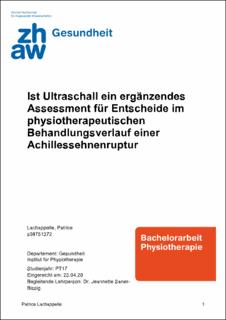Please use this identifier to cite or link to this item:
https://doi.org/10.21256/zhaw-20741Full metadata record
| DC Field | Value | Language |
|---|---|---|
| dc.contributor.advisor | Saner-Bissig, Jeannette | - |
| dc.contributor.author | Lachappelle, Patrice | - |
| dc.date.accessioned | 2020-10-29T14:16:52Z | - |
| dc.date.available | 2020-10-29T14:16:52Z | - |
| dc.date.issued | 2020 | - |
| dc.identifier.uri | https://digitalcollection.zhaw.ch/handle/11475/20741 | - |
| dc.description.abstract | Hintergrund : Die Achillessehnenruptur ist eine der häufigsten Rupturen menschlicher Sehnen. Mit steigender Inzidenz ist sie ein wachsendes Thema in der Physiotherapie. Neben klinischen Tests hat sich die Sonographie mit dem Graustufen-Ultraschall zur Diagnosestellung und dem Therapieentscheid etabliert. Nur wenige Studien begleiteten bisher den Heilungsverlauf sonographisch. Diese Arbeit beabsichtigt, nach Aufarbeitung der aktuellen Literatur über die konservative Therapie nach Achillessehnenruptur, der Wundheilung der Sehnen und ihrer Darstellbarkeit im Graustufen-Ultraschall, das Potential eines sonographisch begleiteten Heilungsverlaufes für die Physiotherapie anhand einer Einzelfallstudie abzuschätzen. Methode : Der Analyse dient eine Literatursuche, der physiotherapeutische Verlauf und sonographische Daten der ersten 6 Monaten nach dem Unfall. Longitudinale Bildsequenzen 6, 8, 14, 19 und 24 Wochen post-trauma wurden mittels Vier-Augenkontrolle ausgewertet und vor dem Hintergrund der Literatur zur Sehnenheilung und dem physiotherapeutischen Verlauf analysiert. Ergebnisse : Der Wundheilungsverlauf im Graustufen-Ultraschall kann sichtbar gemacht werden, ist mit einer Progression im Therapeutischen- und im Wundheilungsverlauf im Einklang und ist womöglich durch Belastung- und Entlastungen beeinflussbar. Schlussfolgerung : Die diagnostische Sonographie hat das Potential sich zukünftig zu einem ergänzenden Tool in der Physiotherapie zu entwickeln. Zur Verifizierung der Ergebnisse müssen jedoch weitere Studien an grösseren Populationen durchgeführt werden. | de_CH |
| dc.description.abstract | Background : The Achilles tendon rupture is considered one of the most common ruptures of human tendons and is with increasing incidence a growing topic in physiotherapy. In addition to clinical tests, sonography with grayscale-ultrasound has established as the method of choice for diagnosis and therapy decisions. However, only a few studies have so far accompanied the healing process sonographically. Therefore, after reviewing the current literature on conservative therapy after Achilles tendon rupture, wound healing of the tendons and their representability in grayscale-ultrasound, this thesis intends to estimate the potential of a sonographically accompanied healing process for physiotherapy based on a single case study. Methods : The analysis is based on a literature search, the physiotherapeutic course and sonographic data of the first 6 months after the accident. Longitudinal image sequences at 6, 8, 14, 19 und 24 weeks post-trauma were evaluated by Four-eye-control and compared with the literature of the tendon healing and the physiotherapeutic course. Results : The course of the wound healing in grayscale-ultrasound can be visualized, is in in accordance with a progression in the therapeutic and healing process and may be influenced by increased and decreased load application. Conclusion : Diagnostic sonography has the potential to become a complementary tool in future physiotherapy assessments. To verify the results found, however further studies on larger populations are needed. | de_CH |
| dc.format.extent | 88 | de_CH |
| dc.language.iso | de | de_CH |
| dc.publisher | ZHAW Zürcher Hochschule für Angewandte Wissenschaften | de_CH |
| dc.rights | https://creativecommons.org/licenses/by/4.0/ | de_CH |
| dc.subject | Achillessehnenruptur | de_CH |
| dc.subject | Ultraschall | de_CH |
| dc.subject | Wundheilung der Sehne | de_CH |
| dc.subject | Achilles tendon rupture | de_CH |
| dc.subject | Tendon healing | de_CH |
| dc.subject | Sonography | de_CH |
| dc.subject | Ultrasound | de_CH |
| dc.subject.ddc | 615.82: Physiotherapie | de_CH |
| dc.subject.ddc | 617.5: Orthopädische Chirurgie | de_CH |
| dc.title | Ist Ultraschall ein ergänzendes Assessment für Entscheide im physiotherapeutischen Behandlungsverlauf einer Achillessehnenruptur | de_CH |
| dc.type | Thesis: Bachelor | de_CH |
| dcterms.type | Text | de_CH |
| zhaw.departement | Gesundheit | de_CH |
| zhaw.publisher.place | Winterthur | de_CH |
| dc.identifier.doi | 10.21256/zhaw-20741 | - |
| zhaw.originated.zhaw | Yes | de_CH |
| Appears in collections: | Abschlussarbeiten Physiotherapie | |
Files in This Item:
| File | Description | Size | Format | |
|---|---|---|---|---|
| Lachappelle_PT17_PT92.pdf | 9.78 MB | Adobe PDF |  View/Open |
Show simple item record
Lachappelle, P. (2020). Ist Ultraschall ein ergänzendes Assessment für Entscheide im physiotherapeutischen Behandlungsverlauf einer Achillessehnenruptur [Bachelor’s thesis, ZHAW Zürcher Hochschule für Angewandte Wissenschaften]. https://doi.org/10.21256/zhaw-20741
Lachappelle, P. (2020) Ist Ultraschall ein ergänzendes Assessment für Entscheide im physiotherapeutischen Behandlungsverlauf einer Achillessehnenruptur. Bachelor’s thesis. ZHAW Zürcher Hochschule für Angewandte Wissenschaften. Available at: https://doi.org/10.21256/zhaw-20741.
P. Lachappelle, “Ist Ultraschall ein ergänzendes Assessment für Entscheide im physiotherapeutischen Behandlungsverlauf einer Achillessehnenruptur,” Bachelor’s thesis, ZHAW Zürcher Hochschule für Angewandte Wissenschaften, Winterthur, 2020. doi: 10.21256/zhaw-20741.
LACHAPPELLE, Patrice, 2020. Ist Ultraschall ein ergänzendes Assessment für Entscheide im physiotherapeutischen Behandlungsverlauf einer Achillessehnenruptur. Bachelor’s thesis. Winterthur: ZHAW Zürcher Hochschule für Angewandte Wissenschaften
Lachappelle, Patrice. 2020. “Ist Ultraschall ein ergänzendes Assessment für Entscheide im physiotherapeutischen Behandlungsverlauf einer Achillessehnenruptur.” Bachelor’s thesis, Winterthur: ZHAW Zürcher Hochschule für Angewandte Wissenschaften. https://doi.org/10.21256/zhaw-20741.
Lachappelle, Patrice. Ist Ultraschall ein ergänzendes Assessment für Entscheide im physiotherapeutischen Behandlungsverlauf einer Achillessehnenruptur. ZHAW Zürcher Hochschule für Angewandte Wissenschaften, 2020, https://doi.org/10.21256/zhaw-20741.
Items in DSpace are protected by copyright, with all rights reserved, unless otherwise indicated.